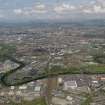Following the launch of trove.scot in February 2025 we are now planning the retiral of some of our webservices. Canmore will be switched off on 24th June 2025. Information about the closure can be found on the HES website: Retiral of HES web services | Historic Environment Scotland
Glasgow, Dalmarnock Sewage Treatment Works
Graffiti (21st Century), Sewage Works (20th Century)
Site Name Glasgow, Dalmarnock Sewage Treatment Works
Classification Graffiti (21st Century), Sewage Works (20th Century)
Alternative Name(s) Dalmarnock Sewage Works; River Clyde
Canmore ID 277713
Site Number NS66SW 965
NGR NS 611 625
NGR Description NS c. 611 625
Datum OSGB36 - NGR
Permalink http://canmore.org.uk/site/277713
- Council Glasgow, City Of
- Parish Glasgow (City Of Glasgow)
- Former Region Strathclyde
- Former District City Of Glasgow
- Former County Lanarkshire
NS66SW 965 c. 611 625
Sewage Works [NAT] (at NS 6105 6240)
OS 1:1250 map, 1968.
This extensive sewage works is situated within a pronounced bow on the N bank of the River Clyde, and about 2.5km SE of the centre of Glasgow.
Individual components of the works are noted on the following OS 1:1250 map sheets: NS6062NE (1974), NS6062SE (1966), NS6162NW (1968) and NS6162SW (1968).
Information from RCAHMS (RJCM), 14 December 2005.
Construction (1893 - 1894)
Project (2007)
This project was undertaken to input site information listed in 'Civil engineering heritage: Scotland - Lowlands and Borders' by R Paxton and J Shipway, 2007.
Publication Account (2007)
Dalmarnock Sewage Treatment Works was Scotland’s first large scale sewage treatment works which, from 1904 with the Dalmuir Works to the west, greatly improved public health in the city. Dalmarnock Works was constructed from 1893–94 to the design of Danish engineer, G. Alsing, an acknowledged authority on chemical precipitation. The treatment then, and still does, involve separating out the solid component of the sewage effluent in settlement tanks in the form of sludge. This was then de-watered in a filter press. Three years later a Cumnor drying plant was installed to produce sludge cake which was marketed as ‘Globe Fertilizer’ for agricultural use. By 1911 32 000 tons per annum were being sold, but it was never possible to utilise the
entire production and, from 1915, the surplus sludge was pumped into a purpose-built boat and taken daily down the Clyde and discharged in the Firth off Garroch Head, Isle of Bute.
Research into the use of more efficient biological filtration occurred from 1913 with the inauguration of two
hectares of filter beds. By the mid-1930s the works were reaching the end of their useful life and, in 1937, an experimental plant using the Simplex Activated Sludge Process was installed, but it was not until 1962–68 that a full activated sludge plant was constructed at a cost of about £4 m. The consulting engineers for this improvement were Babtie, Shaw & Morton.
R Paxton and J Shipway 2007
Reproduced from 'Civil Engineering heritage: Scotland - Lowlands and Borders' with kind permission of Thomas Telford Publishers.




















